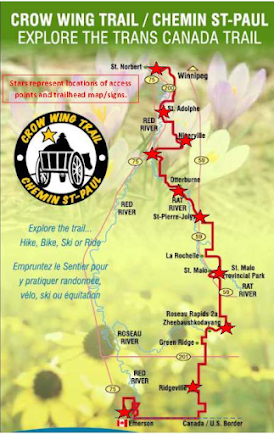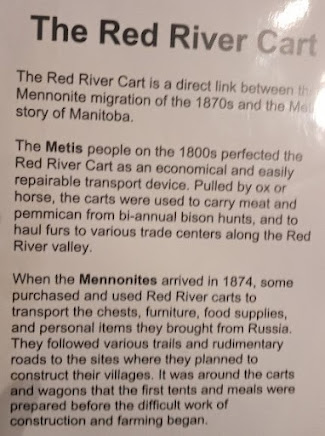In a previous blog on the official opening of the Niverville Historical/Cultural Space Museum on September 30, 2021, the very first National Day for Truth and Reconciliation, it was mentioned that Joseph Wiebe, an Associate Professor of Religion and Ecology in Ethics and Global Studies at the University of Alberta was hired by the Town of Niverville to plan and to organize the space in this museum. Joining him was an ad hoc group of local amateur history supporters and advocates who came alongside and served on a volunteer basis.
The Town of Niverville had pretty much extended its resources just to get the Historical/Cultural Museum up-and-running, but these local history devotees decided that they would like to see the museum enhanced by a symbolic icon that could in a single representation speak to the pre-settlement and post-settlement content of the history lesson conveyed within the museum itself. Upon reflection, it seemed clear that an icon such as the Métis Red River Cart was an appropriate symbol on at least three levels.
The Métis Red River Cart Relates to Niverville's History and Destiny on at Least Three Levels
1. The route of the historic Crow Wing Trail that was used by the Métis Red River Cart Brigades for the purpose of international trade between 1844 and 1878 ran directly through present-day Niverville.
2. The Métis Red River Cart is also a connecting and a transitional link between the pre-settlement people and to the Mennonites and to post-settlement people in our area in and around Niverville and the East Reserve.
3. The Métis as a nation have both European and Indigenous blood flowing through their veins, and as such, in the future process of truth and reconciliation, they hold a strategic potential for being an agent of reconciliation and bridge-building between the different cultures as they can better understand both Indigenous and non-Indigenous mindsets.
We will now go into each of these three factors in more detail.
1. First of all, the route of the historic Crow Wing Trail that was used by the Métis Red River Cart Brigades for the purpose of international trade between 1844 and 1878 ran directly through present-day Niverville. In fact, the site for a train station at Niverville was chosen by Joseph Whitehead to be at a site where the proposed Pembina Branch of the CPR crossed the Crow Wing Trail.

The trail was initially pioneered by Métis trader Peter Garrioch and his men in 1844 as a route to transport goods to and from the Red River Settlement on the Red River at Lower Fort Garry (present-day Winnipeg) and the Crow Wing Settlement in Minnesota on the Mississippi River.
The early journalists spoke of the noise made by the Red River Carts in descriptions such as "you could hear them a squeakin' and a shreikin' long before you could see them." When tied together, the carts formed trains that allowed for commercial international trade between Upper Fort Garry (Winnipeg) on the Red River and the Crow Wing Settlement on the Mississippi River. These cart trains linked settlements together, and opened up present-day southern Manitoba to commerce before the coming of the railway.
Red River carts hauled such goods as pemmican, buffalo hides, furs, moccasins, decorated tanned skin clothes, sugar, tobacco, tea, powder, shot, bullets, point blankets, cloth, axes, knives, files, copper kettles, guns and alcohol. During the fur trade, Red River carts gradually replaced York boats as the main method of cargo hauling because they could carry more goods overall. In addition to its use as a transportation vehicle, the Red River cart served as a temporary home during long trips.
By the 1860s, some 600 carts were making two round trips between Upper Fort Garry and St. Paul, Minnesota (just south of the Crow Wing Settlement) annually, carrying some 270 - 360 kilograms each of trade goods and furs. By the mid-1870s, the carts were gradually replaced by the steamboat and ultimately, the railway which had a station in Niverville by 1878.
So Niverville was right on the route of the historic Crow Wing Trail, running right through Hespeler Park and crossing the railroad near the site of the train station near the intersection of the Heritage Trail and Main Street.
(This is along the trail at the Hespeler Park in Niverville.)
(At the corner of Main Street and Heritage Trail, note the Crow Wing Trail Logo above the arrow.)
2. However, there was a second level at which a Red River Cart seemed to be an appropriate symbolic icon to link to the Niverville Historical/Cultural Museum. Not only was the cart representative of the role of the pre-settlement Métis in our local history, but it was also a connecting and transitional link to the Mennonites and to post-settlement people. Even the Mennonite Village Museum in Steinbach prominently features a Red River Cart with the following description which links the Mennonite Migration of the 1870s and the Métis story of Manitoba.
Even well-known Métis traders like Peter Garrioch and other Métis freighters took some of the earliest and most fragile Mennonite settlers and freight in 1874 - 1876 from the Mennonite Landing Site (at the junction of the Red and Rat Rivers) to the Shantz Immigration Sheds eight kilometres to the East, just a mile south of the south-east corner of Niverville.
The Métis also built the Immigration Sheds in 1874 under the supervision of Jacob Shantz from Ontario. So the construction of the Niverville Historical/ Cultural Museum has caused us to go deeper into our history, and to recognize the important role of the Métis in the lives of the earliest settlers who in turn used those carts and wagons around which they erected tents and prepared meals before the work of construction and farming could begin.
It needs to be clear that the Red River Cart was never intended or even considered to be a replacement for the image of western Canada's first grain elevator as a unique symbol of the Town of Niverville since its beginnings in 1878 after the railway was built. The settlement period of Niverville's history is one that centres around the marketing of grain.
The whole imagery of the Red River Cart is simply intended to be a visible representation of a connecting link to the story of our history as expressed in the Niverville Historical/Cultural Museum, to also be an attraction for tourists and for visitors to visit the museum.
3. The Métis as a nation have both European and Indigenous blood flowing through their veins, and as such, in the future process of truth and reconciliation, they hold a strategic potential to bridge the gap between the different cultures as they can relate to both Indigenous and non-Indigenous perspectives.
The meaning of the Métis flag, with the symbolic representation of a never-ending, horizontal figure "8" speaks of the eternity and the immortality of the Métis nation, and the two blue fields inside of the figure "8" represent the joining of two cultures, indeed, the mixing of two distinct cultures, European and First Nations, to create a unique and distinct culture, that of the Métis (which means “to mix” in Latin).
*************
So the local ad hoc volunteer committee that worked with Joseph Wiebe of the University of Alberta on the layout of the museum decided that they would like to invest in the construction of a Red River Cart that would be connected to the museum and give it a visible expression for local residents as well as visitors to take note of.
This group included Ernie Braun, Steve Neufeld, Clare Braun, Shirley Hoult and Roger Armbruster. Through discussion and negotiation, it was decided that if this group would sponsor the building of the cart, that the Town of Niverville would build a Timber Frame and Cement Pad next door to the Community Resource and Recreation Centre where the cart could be prominently displayed for future generations.
Ernie Braun took the lead in locating a Métis Red River Cart Builder who could build a cart that would be representative of those used in the Red River Region during the 1800s. The search could have gone in a different direction, but it turned out to be the right connection when he met Armand and Kelly Jerome from Beausejour, Manitoba. They are master cart builders who build authentic carts that are representative of those that used to pass through present-day Niverville.
Armand and Kelly Jerome have had the opportunity over
the past years to actually try the carts that they have built out, and have them break
down, and then improve on them. They went
back to the books, back to the research several times, and finally came up with a cart that they believe was the same as the carts that they made back in the 1800s in the Red River area.
This is the Métis Red River Cart Built by Armand and Kelly Jerome for Niverville.
This is a Métis Red River Cart built in the 1800s.
The Ribbon-cutting for Niverville's Métis Red River Cart on Saturday, December 4, 2021
Inside of the Gymnasium of Niverville's new Community Resource and Recreation Centre, a ceremony was held on Saturday, December 4, to honour the role of the Métis in our local history, and to have a ribbon-cutting ceremony for the Métis Red River Cart that had been built for Niverville by Armand and Kelly Jerome. It is clear from this picture that covid restrictions were still very much in place at this time, and the audience was limited to 25 people who were all grateful to be invited to this important community event.
The Emcee for the ceremony was Niverville Mayor Myron Dyck who also shared a speech about the significant role of the Métis people in our local history. He then turned it over to Ernie Braun who introduced Armand and Kelly Jerome, the cart builders who both gave very informative speeches.
To learn more about this ceremony, check out one or even all three of the following links that give media coverage to this ceremony.
The
December 8, 2021, edition of
PembinaValley Online published an article entitled
A Replica Red River Cart Makes its Permanent Home in Niverville that can be accessed at this
location.
The
Niverville Citizen carried the story in their
December 10, 2021 online edition with an article entitled,
Red River Cart at CRRC Speaks to Métis-Mennonite Connection, and can be found at this
site.
Another news story of this ceremony is covered in an article entitled
Métis Cart Rolls into Niverville which was featured in the
December 15, 2021 edition of
The Carillon, and
can be read
here.

After attending the ceremony at the Community Resource and Recreation Centre, those present all came outside to participate in the ribbon-cutting ceremony for the cart at the location where it would eventually be permanently stationed under a Timber Frame adjacent to the parking lot of the CRRC.
Participating in the ribbon-cutting on December 4, 2021, are, left to right: Steve Neufeld, Kelly Jerome, Armand Jerome, Mayor Myron Dyck, Ernie Braun, Shirley Hoult, Roger Armbruster and Clare Braun.
In the centre of the ribbon-cutting are the four people who had just spoken at the ceremony inside of the CRRC a few minutes earlier: Kelly Jerome, Armand Jerome, Mayor Myron Dyck and Ernie Braun.
Here is a close-up picture that illustrates the fine work involved in the construction of this Red River Cart which, like other such carts, were made completely from wood. This made it possible to replace parts on the spot from local trees during travels if there should be a break-down or a need of repairs.

It was becoming clear that the relationship between Ernie Braun of Mennonite background, and Armand Jerome, of Métis background, was becoming what they like to call "the M & M Connection," that is, "the Métis & Mennonite Connection!" Here they are visiting the new Niverville Historical/Cultural Museum which had been officially opened just two months previously on September 30, 2021. They are standing right in front of the statement that is attributed to Métis Leader Louis Riel in 1885 when he said that is is "through the grace of God, I am the founder of Manitoba."
In the mural in St. Norbert, Manitoba, featuring Louis Riel as the Founder of Manitoba, notice at the bottom of the mural the Métis Red River Cart Brigades along the East side of the Red River. By the 1860s, some 600 carts were making two round trips between Upper Fort Garry on the Red River and St. Paul, Minnesota annually, carrying some 270 - 360 kilograms each of trade goods and furs. By the mid-1870s, the carts were gradually replaced by the steamboat and ultimately, the railway which had a station in Niverville by 1878.
This mural at the Niverville Museum shows what Niverville looked like by the year 1900. It shows the location of the train station that Joseph Whitehead chose in 1874 for the location of present-day Niverville, right at the site where the proposed Pembina Branch of the Canadian Pacific Railway and the Crow Wing Trail intersected. As Ernie Braun is pointing out to Armand Jerome, by that time the Métis Red River Cart had fallen into disrepair, disuse and desertion.
With the coming in of the railroad, the land around present-day Niverville no longer centred around the fur trade, but around the shipping of grain, and the first circular grain elevator in western Canada pictured in the background of the picture above is a meaningful emblem of Niverville's settlement period.
However, this newly constructed, authentic Métis Red River Cart from the 1800s is a revitalization of the Métis part in our local history prior to 1878, and it is also contributing to reconciliation by causing the people of Niverville to know their history more completely, and to encourage conversations that are resulting in the strengthening and revitalizing the M & M Connection!
Armand and Kelly Jerome were to return to Niverville on at least two occasions over the next seven months. The first was on Manitoba Day, May 12, 2022, when a cairn was unveiled at the site of the Shantz Immigration Sheds from which the Mennonites branched out to settle in different communities throughout the East Reserve (present-day Rural Municipality of Hanover) and beyond. This cairn is located at a site just one mile south of the south-east corner of Niverville.
The next occasion for Armond and Kelly Jerome to return to Niverville was on Canada Day, July 1, 2022. when the Métis Red River Cart that they had constructed was rolled out into its permanent place underneath a Timber Frame constructed by the Town of Niverville under the supervision of Deputy Mayor John Funk.
By September of 2022, a Roof had been placed over the Timber Frame that shelters the Cart in order to preserve it longer for future generations to witness. Furthermore, a cairn is being planned for the site that will be educational for future generations as well.
Niverville is a Town with a History, and a Town with a Destiny, and will become an even stronger community as its gets more knowledgeable and more deeply connected to its righteous roots.








.jpg)

























Comments
Post a Comment